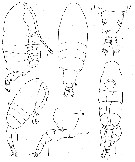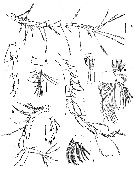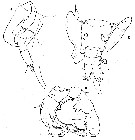|
|
 |
|
Calanoida ( Order ) |
|
|
|
Diaptomoidea ( Superfamily ) |
|
|
|
Acartiidae ( Family ) |
|
|
|
Paralabidocera ( Genus ) |
|
|
| |
Paralabidocera grandispina Waghorn, 1979 (F,M) | |
| | | | | | | Ref.: | | | Waghorn, 1979 (p.465, figs.F,M); Park & Ferrari, 2009 (p.143, Table 1, Appendix 1, biogeography from Southern Ocean) |  issued from : E.I. Waghorn in N. Z. J. Mar. Freshw. Res., 1979, 13 (3). [p.464, Fig.5]. Female (from White Island, Ross Sea): a-b, habitus (lateral and dorsal, respectively); c, urosome (dorsal); e, posterior part of prosome (lateral). Nota: Genital segment asymmetrical, with a posterolateral lobe on left side and sclerotised processes on anterolateral borders. Caudal rami slightly asymmetrical, with 6 setae (1 smaller inner seta, 3 large terminal setae about as long as urosome, and 2 outer edge setae less than half as long as terminal setae. Male: d, habitus (lateral); f, idem (dorsal). Nota: Right A1 modified into a clasping organ, 18-segmented, although several are not distinctly separate; segment 16 with a row of denticles on inner margin; left A1 19-segmented, not all distinctly separateCaudal rami slightly asymmetrical, twice as long as wide. Scale bars 0.1 mm
|
 issued from : E.I. Waghorn in N. Z. J. Mar. Freshw. Res., 1979, 13 (3). [p.466, Fig.6]. Female: d, Md; e, right A1; f, Mxp; g, Mx1; h, A2; i, Mx2. Nota: A1 16-segmented, although some are not distinctly separate. Male: a, left A1; b, right A1; c, right A1 (segments either side of knee). Scale bars 0.1 mm
|
 issued from : E.I. Waghorn in N. Z. J. Mar. Freshw. Res., 1979, 13 (3). [p.467, Fig.7]. Female: e, P5. Male: a, P4; b, P1; c, P3; d, P2. Scale bars 0.1 mm.
|
 issued from : E.I. Waghorn in N. Z. J. Mar. Freshw. Res., 1979, 13 (3). [p.468, Fig.8, a-c ]. Female: urosome and coupler (lateral and dorsal, respectively) Male: P5.< br> Scale bars 0.1 mm.
| | | | | Compl. Ref.: | | | Knox & al., 1996 (tab.1); Razouls & al., 2000 (p.343, tab. 2, 5, Appendix) | | | | NZ: | 1 | | |
|
Distribution map of Paralabidocera grandispina by geographical zones
|
| | | | | | | Loc: | | | Antarct. (Pacif.: White Is., Mc Murdo area, Ross Sea, McMurdo Sound) | | | | N: | 4 | | | | Lg.: | | | (194) F: 1,68-1,56; M: 1,6-1,42; {F: 1,56-1,68; M: 1,42-1,60} | | | | Rem.: | brackish. Sampling depth (Antact.): 0-70 m.
For Waghorn (1979, p.469) this species can be differentiated from antarctica and separabilis by the shape of the genital segment. P. antarctica has 4 symmetrical lobes, 2 on each side. The genital segment of P. separabilis is almost symmetrical, and lacks lobes. The male of grandispina can be distinguished from the other two species by the form of P5. In grandispina the terminal spine on the right P5 leg is about half as long as the 4th segment, but it is less than 1/5 the length of this segment in antarctica (see fig.8d) and separabilis. In grandispina the 1st segment of the left P5 leg has a spinose knob on the inner proximal border, this is hardly developed in antarctica (see fig.8d) and apparently absent in separabilis. | | | Last update : 27/01/2015 | |
|
|
 Any use of this site for a publication will be mentioned with the following reference : Any use of this site for a publication will be mentioned with the following reference :
Razouls C., Desreumaux N., Kouwenberg J. and de Bovée F., 2005-2025. - Biodiversity of Marine Planktonic Copepods (morphology, geographical distribution and biological data). Sorbonne University, CNRS. Available at http://copepodes.obs-banyuls.fr/en [Accessed January 01, 2026] © copyright 2005-2025 Sorbonne University, CNRS
|
|
 |
 |







